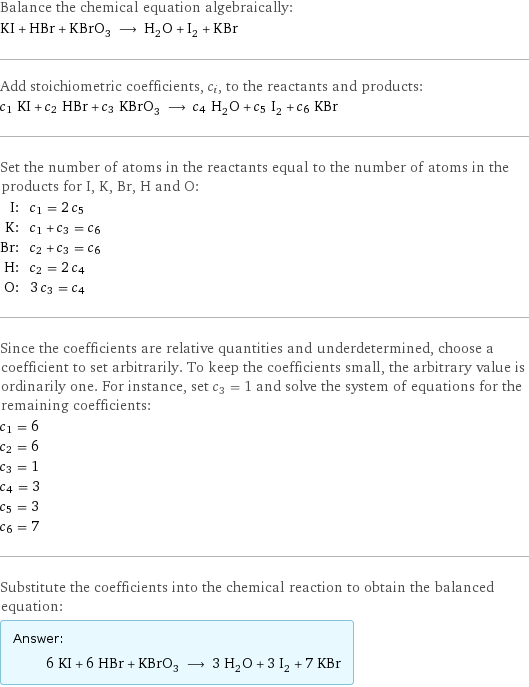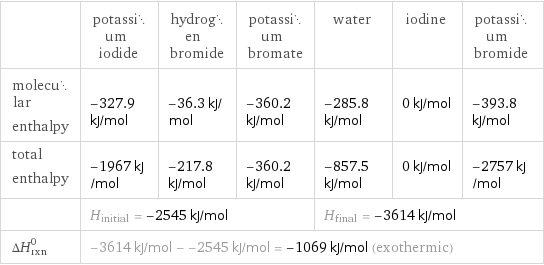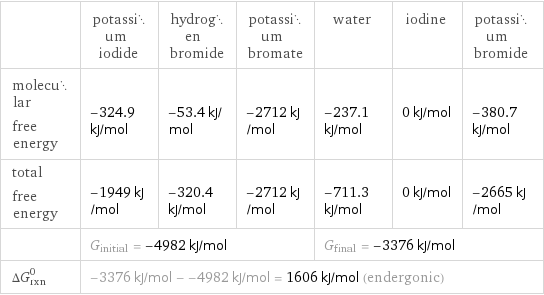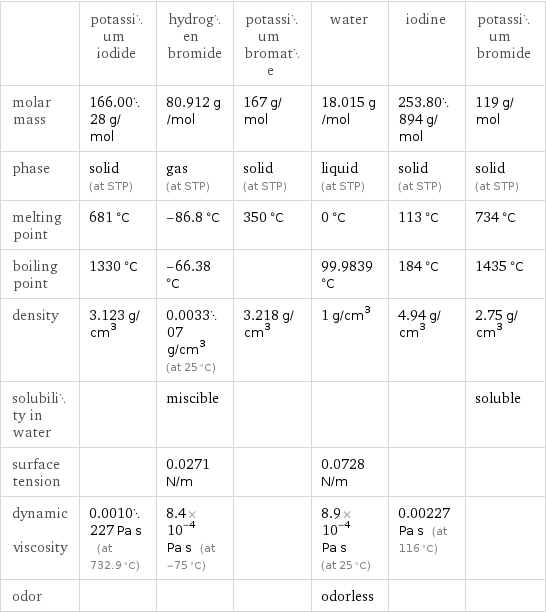Input interpretation

KI potassium iodide + HBr hydrogen bromide + KBrO_3 potassium bromate ⟶ H_2O water + I_2 iodine + KBr potassium bromide
Balanced equation

Balance the chemical equation algebraically: KI + HBr + KBrO_3 ⟶ H_2O + I_2 + KBr Add stoichiometric coefficients, c_i, to the reactants and products: c_1 KI + c_2 HBr + c_3 KBrO_3 ⟶ c_4 H_2O + c_5 I_2 + c_6 KBr Set the number of atoms in the reactants equal to the number of atoms in the products for I, K, Br, H and O: I: | c_1 = 2 c_5 K: | c_1 + c_3 = c_6 Br: | c_2 + c_3 = c_6 H: | c_2 = 2 c_4 O: | 3 c_3 = c_4 Since the coefficients are relative quantities and underdetermined, choose a coefficient to set arbitrarily. To keep the coefficients small, the arbitrary value is ordinarily one. For instance, set c_3 = 1 and solve the system of equations for the remaining coefficients: c_1 = 6 c_2 = 6 c_3 = 1 c_4 = 3 c_5 = 3 c_6 = 7 Substitute the coefficients into the chemical reaction to obtain the balanced equation: Answer: | | 6 KI + 6 HBr + KBrO_3 ⟶ 3 H_2O + 3 I_2 + 7 KBr
Structures

+ + ⟶ + +
Names

potassium iodide + hydrogen bromide + potassium bromate ⟶ water + iodine + potassium bromide
Reaction thermodynamics
Enthalpy

| potassium iodide | hydrogen bromide | potassium bromate | water | iodine | potassium bromide molecular enthalpy | -327.9 kJ/mol | -36.3 kJ/mol | -360.2 kJ/mol | -285.8 kJ/mol | 0 kJ/mol | -393.8 kJ/mol total enthalpy | -1967 kJ/mol | -217.8 kJ/mol | -360.2 kJ/mol | -857.5 kJ/mol | 0 kJ/mol | -2757 kJ/mol | H_initial = -2545 kJ/mol | | | H_final = -3614 kJ/mol | | ΔH_rxn^0 | -3614 kJ/mol - -2545 kJ/mol = -1069 kJ/mol (exothermic) | | | | |
Gibbs free energy

| potassium iodide | hydrogen bromide | potassium bromate | water | iodine | potassium bromide molecular free energy | -324.9 kJ/mol | -53.4 kJ/mol | -2712 kJ/mol | -237.1 kJ/mol | 0 kJ/mol | -380.7 kJ/mol total free energy | -1949 kJ/mol | -320.4 kJ/mol | -2712 kJ/mol | -711.3 kJ/mol | 0 kJ/mol | -2665 kJ/mol | G_initial = -4982 kJ/mol | | | G_final = -3376 kJ/mol | | ΔG_rxn^0 | -3376 kJ/mol - -4982 kJ/mol = 1606 kJ/mol (endergonic) | | | | |
Equilibrium constant
![Construct the equilibrium constant, K, expression for: KI + HBr + KBrO_3 ⟶ H_2O + I_2 + KBr Plan: • Balance the chemical equation. • Determine the stoichiometric numbers. • Assemble the activity expression for each chemical species. • Use the activity expressions to build the equilibrium constant expression. Write the balanced chemical equation: 6 KI + 6 HBr + KBrO_3 ⟶ 3 H_2O + 3 I_2 + 7 KBr Assign stoichiometric numbers, ν_i, using the stoichiometric coefficients, c_i, from the balanced chemical equation in the following manner: ν_i = -c_i for reactants and ν_i = c_i for products: chemical species | c_i | ν_i KI | 6 | -6 HBr | 6 | -6 KBrO_3 | 1 | -1 H_2O | 3 | 3 I_2 | 3 | 3 KBr | 7 | 7 Assemble the activity expressions accounting for the state of matter and ν_i: chemical species | c_i | ν_i | activity expression KI | 6 | -6 | ([KI])^(-6) HBr | 6 | -6 | ([HBr])^(-6) KBrO_3 | 1 | -1 | ([KBrO3])^(-1) H_2O | 3 | 3 | ([H2O])^3 I_2 | 3 | 3 | ([I2])^3 KBr | 7 | 7 | ([KBr])^7 The equilibrium constant symbol in the concentration basis is: K_c Mulitply the activity expressions to arrive at the K_c expression: Answer: | | K_c = ([KI])^(-6) ([HBr])^(-6) ([KBrO3])^(-1) ([H2O])^3 ([I2])^3 ([KBr])^7 = (([H2O])^3 ([I2])^3 ([KBr])^7)/(([KI])^6 ([HBr])^6 [KBrO3])](../image_source/2b5012de1a47cea29ac309840fd59a8e.png)
Construct the equilibrium constant, K, expression for: KI + HBr + KBrO_3 ⟶ H_2O + I_2 + KBr Plan: • Balance the chemical equation. • Determine the stoichiometric numbers. • Assemble the activity expression for each chemical species. • Use the activity expressions to build the equilibrium constant expression. Write the balanced chemical equation: 6 KI + 6 HBr + KBrO_3 ⟶ 3 H_2O + 3 I_2 + 7 KBr Assign stoichiometric numbers, ν_i, using the stoichiometric coefficients, c_i, from the balanced chemical equation in the following manner: ν_i = -c_i for reactants and ν_i = c_i for products: chemical species | c_i | ν_i KI | 6 | -6 HBr | 6 | -6 KBrO_3 | 1 | -1 H_2O | 3 | 3 I_2 | 3 | 3 KBr | 7 | 7 Assemble the activity expressions accounting for the state of matter and ν_i: chemical species | c_i | ν_i | activity expression KI | 6 | -6 | ([KI])^(-6) HBr | 6 | -6 | ([HBr])^(-6) KBrO_3 | 1 | -1 | ([KBrO3])^(-1) H_2O | 3 | 3 | ([H2O])^3 I_2 | 3 | 3 | ([I2])^3 KBr | 7 | 7 | ([KBr])^7 The equilibrium constant symbol in the concentration basis is: K_c Mulitply the activity expressions to arrive at the K_c expression: Answer: | | K_c = ([KI])^(-6) ([HBr])^(-6) ([KBrO3])^(-1) ([H2O])^3 ([I2])^3 ([KBr])^7 = (([H2O])^3 ([I2])^3 ([KBr])^7)/(([KI])^6 ([HBr])^6 [KBrO3])
Rate of reaction
![Construct the rate of reaction expression for: KI + HBr + KBrO_3 ⟶ H_2O + I_2 + KBr Plan: • Balance the chemical equation. • Determine the stoichiometric numbers. • Assemble the rate term for each chemical species. • Write the rate of reaction expression. Write the balanced chemical equation: 6 KI + 6 HBr + KBrO_3 ⟶ 3 H_2O + 3 I_2 + 7 KBr Assign stoichiometric numbers, ν_i, using the stoichiometric coefficients, c_i, from the balanced chemical equation in the following manner: ν_i = -c_i for reactants and ν_i = c_i for products: chemical species | c_i | ν_i KI | 6 | -6 HBr | 6 | -6 KBrO_3 | 1 | -1 H_2O | 3 | 3 I_2 | 3 | 3 KBr | 7 | 7 The rate term for each chemical species, B_i, is 1/ν_i(Δ[B_i])/(Δt) where [B_i] is the amount concentration and t is time: chemical species | c_i | ν_i | rate term KI | 6 | -6 | -1/6 (Δ[KI])/(Δt) HBr | 6 | -6 | -1/6 (Δ[HBr])/(Δt) KBrO_3 | 1 | -1 | -(Δ[KBrO3])/(Δt) H_2O | 3 | 3 | 1/3 (Δ[H2O])/(Δt) I_2 | 3 | 3 | 1/3 (Δ[I2])/(Δt) KBr | 7 | 7 | 1/7 (Δ[KBr])/(Δt) (for infinitesimal rate of change, replace Δ with d) Set the rate terms equal to each other to arrive at the rate expression: Answer: | | rate = -1/6 (Δ[KI])/(Δt) = -1/6 (Δ[HBr])/(Δt) = -(Δ[KBrO3])/(Δt) = 1/3 (Δ[H2O])/(Δt) = 1/3 (Δ[I2])/(Δt) = 1/7 (Δ[KBr])/(Δt) (assuming constant volume and no accumulation of intermediates or side products)](../image_source/eb204169c7077c5fff7e7392e8b5abe8.png)
Construct the rate of reaction expression for: KI + HBr + KBrO_3 ⟶ H_2O + I_2 + KBr Plan: • Balance the chemical equation. • Determine the stoichiometric numbers. • Assemble the rate term for each chemical species. • Write the rate of reaction expression. Write the balanced chemical equation: 6 KI + 6 HBr + KBrO_3 ⟶ 3 H_2O + 3 I_2 + 7 KBr Assign stoichiometric numbers, ν_i, using the stoichiometric coefficients, c_i, from the balanced chemical equation in the following manner: ν_i = -c_i for reactants and ν_i = c_i for products: chemical species | c_i | ν_i KI | 6 | -6 HBr | 6 | -6 KBrO_3 | 1 | -1 H_2O | 3 | 3 I_2 | 3 | 3 KBr | 7 | 7 The rate term for each chemical species, B_i, is 1/ν_i(Δ[B_i])/(Δt) where [B_i] is the amount concentration and t is time: chemical species | c_i | ν_i | rate term KI | 6 | -6 | -1/6 (Δ[KI])/(Δt) HBr | 6 | -6 | -1/6 (Δ[HBr])/(Δt) KBrO_3 | 1 | -1 | -(Δ[KBrO3])/(Δt) H_2O | 3 | 3 | 1/3 (Δ[H2O])/(Δt) I_2 | 3 | 3 | 1/3 (Δ[I2])/(Δt) KBr | 7 | 7 | 1/7 (Δ[KBr])/(Δt) (for infinitesimal rate of change, replace Δ with d) Set the rate terms equal to each other to arrive at the rate expression: Answer: | | rate = -1/6 (Δ[KI])/(Δt) = -1/6 (Δ[HBr])/(Δt) = -(Δ[KBrO3])/(Δt) = 1/3 (Δ[H2O])/(Δt) = 1/3 (Δ[I2])/(Δt) = 1/7 (Δ[KBr])/(Δt) (assuming constant volume and no accumulation of intermediates or side products)
Chemical names and formulas

| potassium iodide | hydrogen bromide | potassium bromate | water | iodine | potassium bromide formula | KI | HBr | KBrO_3 | H_2O | I_2 | KBr Hill formula | IK | BrH | BrKO_3 | H_2O | I_2 | BrK name | potassium iodide | hydrogen bromide | potassium bromate | water | iodine | potassium bromide IUPAC name | potassium iodide | hydrogen bromide | potassium bromate | water | molecular iodine | potassium bromide
Substance properties

| potassium iodide | hydrogen bromide | potassium bromate | water | iodine | potassium bromide molar mass | 166.0028 g/mol | 80.912 g/mol | 167 g/mol | 18.015 g/mol | 253.80894 g/mol | 119 g/mol phase | solid (at STP) | gas (at STP) | solid (at STP) | liquid (at STP) | solid (at STP) | solid (at STP) melting point | 681 °C | -86.8 °C | 350 °C | 0 °C | 113 °C | 734 °C boiling point | 1330 °C | -66.38 °C | | 99.9839 °C | 184 °C | 1435 °C density | 3.123 g/cm^3 | 0.003307 g/cm^3 (at 25 °C) | 3.218 g/cm^3 | 1 g/cm^3 | 4.94 g/cm^3 | 2.75 g/cm^3 solubility in water | | miscible | | | | soluble surface tension | | 0.0271 N/m | | 0.0728 N/m | | dynamic viscosity | 0.0010227 Pa s (at 732.9 °C) | 8.4×10^-4 Pa s (at -75 °C) | | 8.9×10^-4 Pa s (at 25 °C) | 0.00227 Pa s (at 116 °C) | odor | | | | odorless | |
Units
